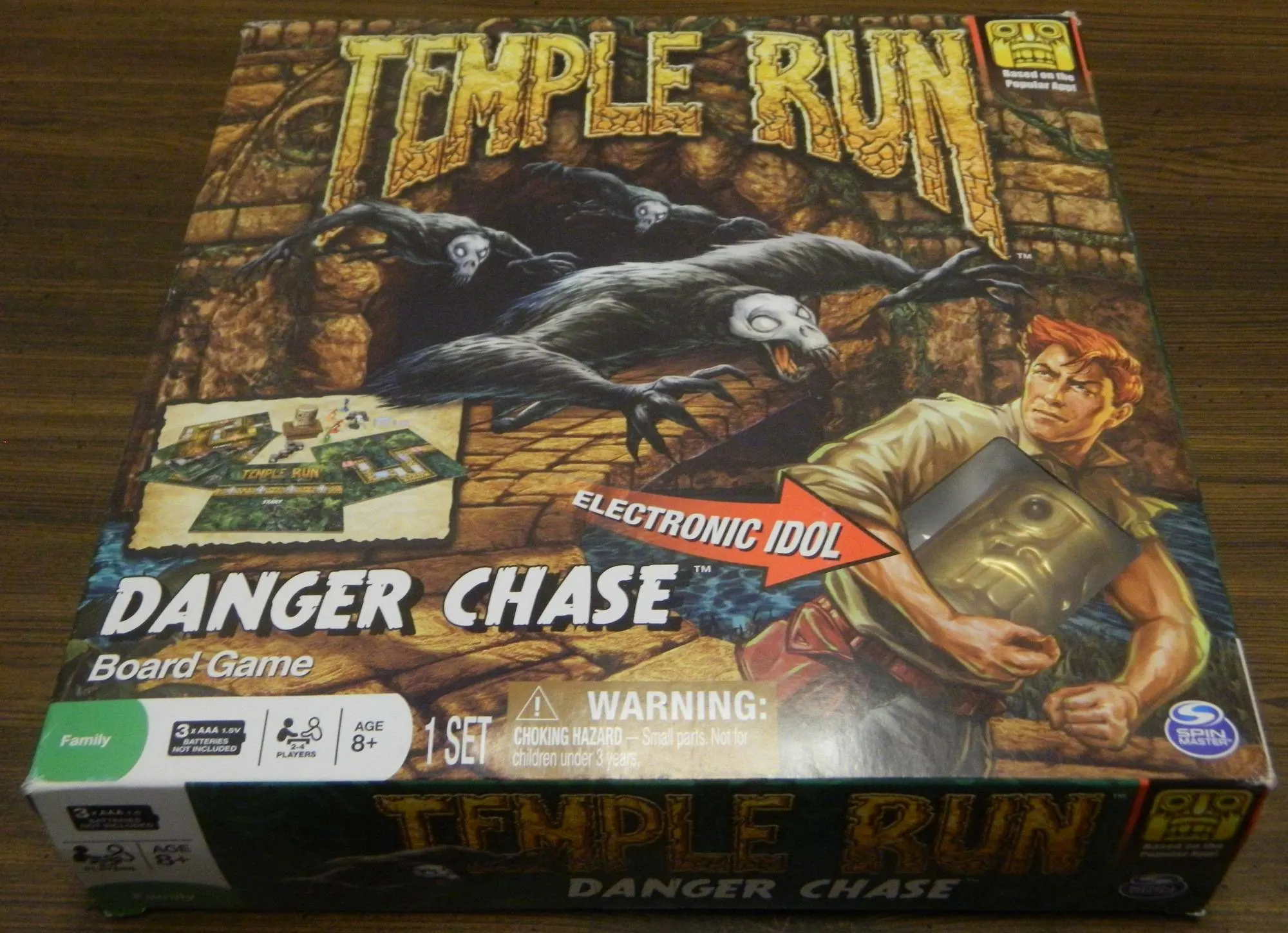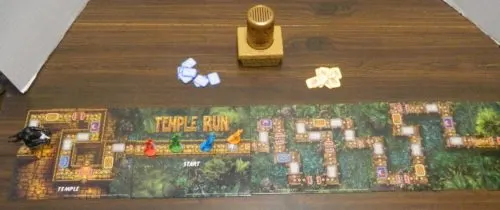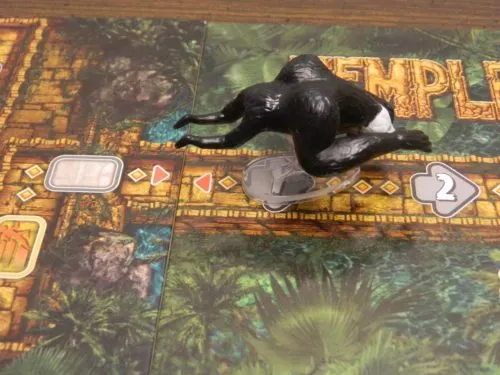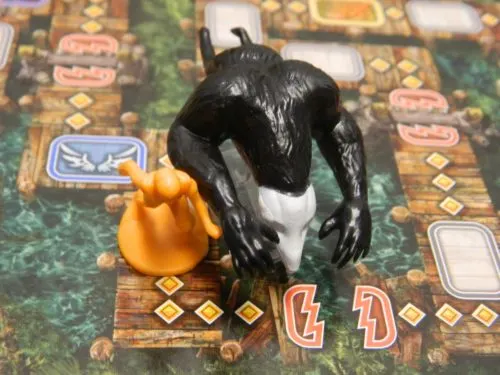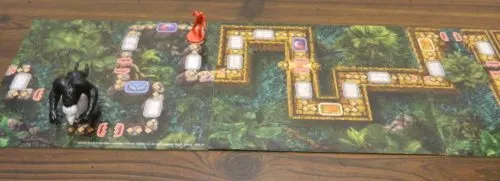First released in 2011, Temple Run is a series of mobile games that were huge for a few years. The basic premise of the game is that the player would play as an explorer who comes upon an ancient temple. After stealing the gold idol from the temple, a group of demonic monkeys chase after the player. Players need to avoid obstacles in order to keep running away for as long as possible. Around the time that Temple Run was released, board game publishers started to produce board games based off of popular mobile games. It wasn’t surprising that Temple Run got a board game. It was a little more surprising that the game actually ended up getting two games, a card game and a dice game. Today I am looking at the dice game, Temple Run: Danger Chase. While I like speed dice games, I can’t say that I had high expectations for the game as it looked like another cheap tie-in game. Temple Run: Danger Chase surprised me a little as more effort was put in to the game than you typically get from a licensed game but it still has its own issues.
How to Play Temple Run: Danger Chase
Setup
- Assemble the starting game board. Place the temple tile on the far left followed by the “start” tile. Randomly add the three other tiles to the right of the temple tile. When placing the tiles make sure the red arrow is touching the red arrow on the previous tile.
- Place the “evil demon monkey” pawn on the monkey symbol on the temple tile.
- Each player chooses a runner pawn. The players choose which player will start the game. The starting player will place their pawn on the “1” space on the start tile. The player to their left (clockwise) will place their pawn on “2” and so on.
- Separate the power tokens by their type. Each player is given one token of each type to start the game. Place the rest of the tokens near the gameboard.
- The players choose which difficulty setting they would like to set the idol timer to.
- The five dice and the idol timer are given to the starting player.
Playing the Game
Before a player begins their turn they should analyze the track in front of them to figure out which numbers they want to roll and which numbers they must avoid.
The player also has to choose whether they want to use a boost/yellow token if they have any. These tokens must be used before the player begins rolling the dice. If a boost token is used, the player will move twice as many spaces as they would normally move. The monkey’s movement is not doubled.
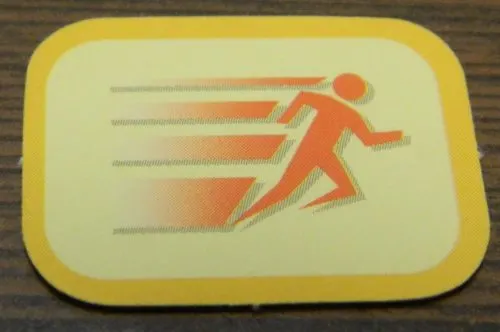
This player has chosen to use one of their boost tokens. They will get to move their pawn twice as many spaces.
Rolling the Dice
When a player is ready they will press the top of the timer idol which starts the timer. The player will then roll their dice. The player can re-roll as many of the dice as they want as many times as they want. The player cannot re-roll any of the monkey symbols they roll.

For this player’s first die roll they rolled three runner symbols and one monkey. The monkey die cannot be re-rolled but any of the other dice can be re-rolled.
If a player is satisfied with their roll, they hit the top of the idol in order to stop the timer. If the timer plays a cymbal sound, the player stopped the timer in time and they get to use the dice they rolled. If the timer plays a screeching monkey sound, the player took too long. The player doesn’t get to use any of the runner symbols they rolled. They will move their pawn one space behind the pawn in last place. If the player was already in last place, their pawn will be moved back one space.

This player has ended their turn. They have rolled four runner symbols so they will get to move their piece forward four spaces. The monkey will then be moved forward two spaces.
Moving Your Pawn
If a player stopped the timer in time, they will first move their own pawn forward. The player will move their pawn forward one space for each runner symbol they rolled. Dice that show two runner symbols count as two spaces. If a player’s pawn lands on a space occupied by another pawn, they will move their pawn to the next unoccupied space. The player will then take a special action if they land on one of the special spaces:
 Red Space: If the player has a blue “resurrect” token, they can use it in order to stay in the game. If the player doesn’t have any blue tokens, they are eliminated from the game.
Red Space: If the player has a blue “resurrect” token, they can use it in order to stay in the game. If the player doesn’t have any blue tokens, they are eliminated from the game. Blue/Yellow Space: The player will take one of the corresponding tokens from the piles near the game board.
Blue/Yellow Space: The player will take one of the corresponding tokens from the piles near the game board.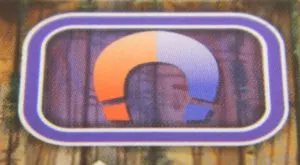 Purple Space: The current player will get to steal a power up from one of the other players. If no one has a power up token, the player gets no benefit from landing on a purple space.
Purple Space: The current player will get to steal a power up from one of the other players. If no one has a power up token, the player gets no benefit from landing on a purple space.
If a player reaches the end of the last tile, the first tile is removed from the beginning of the track and moved to the end. If the demon monkey was still on that tile, it is moved to the first space on the next tile.
Moving the Evil Demon Monkey
After a player has moved their pawn, they will move the evil demon monkey. The evil demon monkey will be moved forward one space for each monkey symbol rolled. If the Evil Demon Monkey reaches the next tile, flip over the tile and add it to the end of the track (making sure the arrows connect).
If a monkey reaches or passes one or more of the runners, those players are eliminated from the game. Their pawn is removed from the board and any power ups they had are returned to the piles by the board. When a player is eliminated they will still take their turn. They will get to roll the dice once. The monkey is moved forward one space for each monkey symbol that is rolled.
End of Game
The game ends when there is only one runner remaining. The last remaining runner wins the game. If all of the remaining runners are eliminated on the same turn, the runner that was furthest along the track wins the game.
My Thoughts on Temple Run: Danger Chase
I have to admit that I have never played any of the Temple Run mobile games which Temple Run: Danger Chase is based on. This is mostly due to the fact that I have never been much of a fan of mobile video games. Based on what I know of the app though, Temple Run: Danger Chase actually seems to do a good job recreating the app inside a board game.
As I mentioned at the beginning of this review, I did not have high expectations going into Temple Run: Danger Chase. Tie-in games tend to not have a great reputation as they are usually quickly slapped together to make a quick buck off the popularity of the license before it loses its popularity. While Temple Run: Danger Chase has some of its own problems, which I will get to later, it actually feels like real effort was put into making the best game they could based on the Temple Run license.
At its core Temple Run: Danger Chase feels like your typical dice rolling game, similar to Yahtzee. Players take turns rolling the dice with an opportunity to re-roll dice in order to try and get better symbols. Unlike Yahtzee though, the players have a time limit in order to roll the dice. Players can roll the dice as many times as they want but they only have a certain amount of time to roll the dice. In this way Temple Run: Danger Chase is similar to most speed dice games. This is not necessarily a bad thing as it is fun trying to roll the dice as quick as possible to try and improve your roll.
Where Temple Run: Danger Chase differs from your typical speed dice rolling game is that it adds a risk/reward mechanic. In most speed dice games, you get to keep rolling until you run out of time. You can end your turn at any time but there is no punishment for rolling until you run out of time. This is not the case in Temple Run: Danger Chase. If you don’t end your turn in time, you lose everything you earned during your turn. This adds an interesting risk/reward mechanic to the game. The longer you roll the dice, the better the chance you have to move your pawn further. You don’t want to wait too long to end your turn and lose everything though. This can actually be kind of stressful but also exciting as you have no idea how much time you have left.
The other area where Temple Run: Danger Chase differs from a lot of speed games is that there are actual traps in the game. Before you begin your turn you want to figure out what numbers will make you land on any of the upcoming traps. You want to avoid landing on these spaces especially if you don’t have a resurrect token. This adds an interesting dynamic to the speed mechanic as players are trying to roll as quickly as possible while also counting runner symbols to make sure they don’t land on a trap space. Instead of just rolling as quickly as possible, this adds some strategy to the game. While you would normally want to keep rolling to move further, you might settle for less spaces just so you can avoid a trap or even land on a space that gives you a power up.
You would think that it would be really easy to avoid the traps but things are not quite as easy as you would think. When you are rushing to roll dice as quickly as possible, you are surprisingly susceptible to ending your turn with a roll that will land you directly in a trap. Accidentally killing yourself in the game can be quite funny for the other players. It becomes kind of frustrating though for the player that makes the mistake. You could be in first place and immediately lose just because you landed on a trap space.
I was genuinely surprised by quite a few things in Temple Run: Danger Chase. I actually had more fun with the game than I was expecting. Like most speed games it is fun trying to roll the dice as quickly as possible to beat the clock. People who like these type of games should enjoy Temple Run: Danger Chase as well. The game is quite simple where the game can be enjoyed by children and adults that don’t play a lot of board games. The game also plays pretty quickly so it will work well as a filler game.
Unfortunately there are some problems with the game which prevents it from being anything more than a very solid but unspectacular game.
I would say that the biggest problem with the game is that the timer does not give you nearly enough time. Even on the easiest difficulty you can only get a couple rolls in before you run out of time. I like the fact that the game includes three different time limits, but they all seem too short. The game should have had at least one setting which gave you enough time to roll several times before you had to end your turn. With having to waste time making sure you don’t land in a trap, you don’t get a lot of time to try and improve your roll. After two or so rolls you really need to consider taking any roll that won’t land you in a trap. You don’t want to keep rolling and run out of time and be sent to the back of the pack. At the same time you don’t want to have to take a roll that will land you in a trap and kill you.
The fact that you don’t have a lot of time to roll your dice means that you aren’t able to get a big lead on the demon monkey. Unless you get a really strong roll early on, you will only gain a couple spaces on the monkey on your turn. If you are playing with four players, the monkey will get four opportunities to move while you only get one. Therefore it is hard to stay ahead of the monkey. Especially if a player fails to end their turn in time, they can be caught quickly. This leads to games ending quickly unless the players roll really well. The game just rushes you too much at times which hurts the experience.
Even though this is to be expected from a dice game, there is still a high reliance on luck in the game. Outside of figuring out which spaces you want to land on and which you need to avoid, there isn’t a lot of strategy to the game. Basically you can choose to press your luck and continue rolling or end your turn early. Otherwise your fate in the game is going to come down to who rolls the best and makes their decisions quickest. I don’t really expect a lot of strategy in this type of game but I wish there was a little more in the game.
The final “complaint” that I have with Temple Run: Danger Chase is not really about the game itself. Unfortunately for Temple Run: Danger Chase, there have been quite a few other speed dice games released over the years. While Temple Run: Danger Chase is a fun game, there are similar games that are clearly superior. One game in particular is Escape The Curse of the Temple. In Escape The Curse of the Temple all of the players are working cooperatively. Players roll dice in order to move through a temple and gather treasure. In order to win the game the players have to gather all of the treasure and escape before they run out of time. While these two games have similar mechanics and actually came out the same year, Escape The Curse of the Temple is clearly superior in my opinion. Having played both games there isn’t much that Temple Run: Danger Chase offers that Escape The Curse of the Temple doesn’t do better.
To wrap up I want to quickly talk about the game’s components. Being a cheap tie-in game I have to say that I was actually kind of impressed by the component quality especially as I am assuming the game was originally pretty cheap. While all of the runner pawns are one-color plastic pieces, they show a decent amount of detail. The demon monkey is even somewhat of a miniature figure even if it is not the most detailed. Outside of the timer not giving you enough time, it works well. I also thought it was quite clever that the game uses a revolving game board. When you finish with one board, the last board is added onto the end so you don’t have to worry about running out of spaces. While I wish the game included more board parts, this adds some variety to the game.
Should You Buy Temple Run: Danger Chase?
I didn’t have high expectations for Temple Run: Danger Chase but I was actually a little surprised. For a tie-in game I was surprised that there was a decent amount of effort put into the game. At its core Temple Run: Danger Chase is a speed dice rolling game where players can keep re-rolling their dice until they run out of time. Players need to be decisive though because if they take too long to end their turn, they lose all of the beneficial symbols they rolled. Adding in the trap spaces, there are some interesting risk/reward mechanics in the game. Like most speed dice rolling games, there is just something fun about rolling the dice as quickly as possible. The game is also accessible enough that children and adults that don’t play a lot of board games shouldn’t have any problems playing the game. Unfortunately the timer is too short which severely limits how many times you can re-roll the dice. The game also relies heavily on luck. While I had more fun with Temple Run: Danger Chase than I was expecting, there are better speed dice rolling games out there.
People who don’t like speed or dice rolling games probably won’t like Temple Run: Danger Chase. If you already own a game like Escape The Curse of the Temple, I don’t really see the point of playing Temple Run: Danger Chase as it is a worse game in my opinion. If you like speed dice games though and can find it for cheap (which shouldn’t be hard with how often I find it at thrift stores), I think it is worth picking up Temple Run: Danger Chase.
If you would like to purchase Temple Run: Danger Chase, you can find it online: Amazon, eBay

